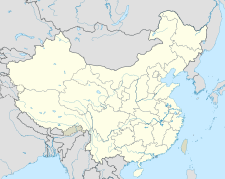Guangyun Temple (simplified Chinese: 广允缅寺; traditional Chinese: 廣允緬寺; pinyin: Guǎngyǔnmiǎn Sì), also known as Xuetang Temple (simplified Chinese: 学堂缅寺; traditional Chinese: 學堂緬寺; lit. 'School Temple'), is a Buddhist temple located in the Cangyuan Va Autonomous County of Yunnan, China.[1]
| Guangyun Temple | |
|---|---|
广允缅寺 | |
| Religion | |
| Affiliation | Theravada |
| Prefecture | Cangyuan Va Autonomous County |
| Province | Yunnan |
| Location | |
| Country | China |
| Prefecture | Cangyuan Va Autonomous County |
| Geographic coordinates | 23°09′18″N 99°14′59″E / 23.1549°N 99.2497°E |
| Architecture | |
| Style | Chinese architecture |
| Funded by | Yunnan government |
| Date established | 1821-1850 |
| Completed | 1828 |
History
editGuangyun Temple was first built in 1828 by the Yunnan government, in the Daoguang period (1821–1850) in the Qing dynasty (1644–1911), it is influenced by the architectural style of Han Chinese buildings and at the same time preserves the basic form of the Theravada Buddhist temples.[1][2]
On January 13, 1988, the temple was listed among the "Major National Historical and Cultural Sites" by the State Council of China.
Architecture
editGuangyun Temple has three existing buildings, includes the main hall and two gates.
Main Hall
editThe main hall, 14.8-metre (49 ft) wide and 24.4-metre (80 ft) deep, is a circuit gallery-style (围廊式样) hall with a double eave pavilion (重檐亭阁) which is in front of the temple and forms the hall. The pillars before the door are engraved with two vivid wooden Chinese dragons in sore straits. The doors and windows of the main hall are carved with openwork patterns, which show proficient skills. Inner walls are painted with 10 frescos, mostly of which are colored after outlined by ink. The styles and techniques are similar with that in the central plain areas in the Ming (1368–1644) and Qing dynasties (1644–1911). Belonging to Han Chinese architectural styles, the buildings of paintings are double eaves hip and gable roof (重檐歇山顶) with human figures of officials, women, soldiers, attendants and others from different ethnic groups.[1][2][3]
See also
editReferences
edit- ^ a b c Zi Yan (2012). Famous Temples in China (in English and Chinese). Hefei, Anhui: Huangshan Publishing House. pp. 168–169. ISBN 978-7-5461-3146-7.
- ^ a b "Guangyunmian Temple". China.org (in Chinese). 2006-12-06.
- ^ Peng Gezi (2006). "Guangyunmian Temple and the Wa People's Wooden Drum" 《广允缅寺和佤族木鼓》. 《边疆文学》 [Frontier Literature] (in Chinese). Vol. 10. Kunming, Yunnan: Yunnan Writers Association. pp. 46–48. ISSN 1007-4155.

